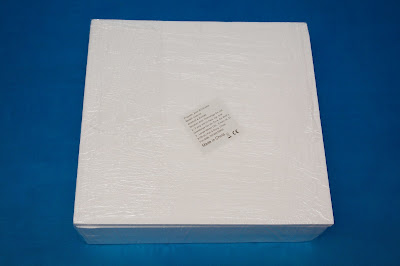One is the Car System developed by Faller. It looks very promising and allows even remote digital control of the units. But that system is unfortunately focused around H0 scale and its smaller N scale version is very limited..
The other is Tomytec bus system. It's noticeably cheaper than Faller and it offers much more when it comes to the 1/150 scale. The company has recently released an updated version of the product and I decided to give it a try.
I ordered a starter set from my favorite Asian Plaza Japan store. It arrived around 3 weeks later. Unwrapping the package revealed a nice looking, colorful box.
The box contains several elements protected inside a transparent plastic mold and a manual. Everything arrived in perfect condition even though the cardboard box was not very well sealed.
The set consists of several road pieces. These allow us to build an oval 67cm long and 44cm wide.
In addition we get:
- USB charging cable
- bus stop building kit
- spare tires
- road connectors
- magnets for controlling the bus
The manual is entirely in Japanese. Fortunately it's not all that complicated and the pictures help a lot.
And here's the bus itself. The new version of the Tomytec system features a longer, articulated vehicle. The set actually contains three items: a bus body, a static chassis and a motorized chassis. The model is designed for Japanese roads, with doors on its left side.
The way the model is delivered it has to be disassembled in order to replace the static base with a powered one. Unfortunately the bus loses all its interior details in this process.
The bottom of the motorized chassis reveals the magnetic steering mechanism and a micro-USB charging port. The USB solution is a novelty - the older system uses small batteries instead.
The bus body easily snaps onto the chassis but there's a surprise - it does not fit by default and the middle wheels go in contact with the fenders.
Luckily one of the pictures in the manual provides a solution. There's a screw on the bottom of the model which allows tuning the length of the chassis. But I still wonder why it couldn't fit by default...
Each road piece features a very thin wire underneath. That wire makes the magnetic steering mechanism on the bus follow the correct path. This concept is identical to the Faller system. I wonder whether the two solutions on the market are compatible...
The three included magnets go under the road pieces. They make the bus slow down, speed up and wait at the stop. Unfortunately my Japanese was not good enough to learn that from the manual, but luckily there's a great page in English explaining that: Sumida Crossing
Building the bus stop requires some plastic cement which is not included. The structure is however very small, and literally 8 drops of any glue are enough.
The vehicle fits the bus stop pretty nicely.
Another feature added in the new version of the system are the front lights which look really cool...
...and the back lights which are very dim.
Here's the complete set in one photo. An oval road, a bus stop and the motorized vehicle.
Once the bus is charged, it works immediately without any extra steps. The following video shows various scenarios, including some extra road pieces I purchased separately.
The bus runs nicely, most of the time. It did have problems here and there and went off the road occasionally. Unfortunately it's not a completely smooth experience but it works pretty well.
One of the things that - I think - causes problems is the articulated body. For some reason the back part does not slide left and right easily enough which causes the vehicle to be stiff and not follow the road perfectly. The video shows very well that a chassis without a body rides much better than a complete model. Perhaps it's something that can be tuned but I'm a little disappointed that it's not flawless out of the box.
Would I recommend the product? Difficult to say... It definitely has a potential and is very nicely made overall. But unfortunately it does not ride as well as I expected and I feel I'll have to spend some time on it to make it perform the way I want.































